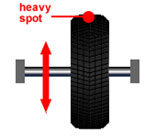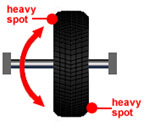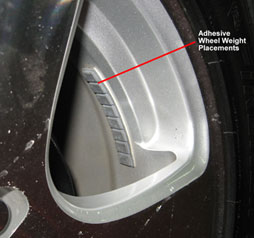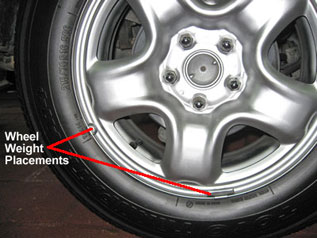All about tyre balancing
01 Sep 2007|52,376 views
What is an imbalanced tyre
An imbalanced tyre is a tyre/wheel assemble with uneven distribution of mass about the centre-line.
When a tyre is mounted onto the rim, two slightly imperfect units are joined to form an assembly weighing almost 20kg (the average for cars). Chances of this assembly having absolutely precise weight distribution about its radial and lateral centers is virtually impossible. It takes just 50g of uneven weight distribution for a vibration to be felt. The illustration below shows how an imbalance creates vibration.
The static imbalance causes vertical vibration. The dynamic imbalance creates a side-to-side wobbling vibration. Most assemblies have both types of imbalance, and require dynamic balancing (commonly referred to as spin balancing) to create even weight distribution.
How do I know that my tyres are imbalanced
An easy way to find out if your vehicle tyres are imbalanced is to see if your steering wheel wobbles when driving at high speeds. The lighter your car is, the more likely it is to be affected by imbalanced tyres. This is due to its weight being unable to dampen the vibrations caused by the imbalanced tyres. A driver may not always sense an imbalance at the steering wheel. It could be present but dampened by the vehicle weight or the suspensions. The best way to determine if you have perfectly balanced tyres is to bring it to your mechanic. That should set you back by no more than S$30 for all four wheels.
What is tyre balancing
The process of tyre balancing is to make sure that the weight of the tyre, when mounted on its wheel and the vehicle's axle, is uniformly distributed around the axle. Or, in simple terms, there should be no heavy spots on the tyre.
To perform tyre balancing, the tyres will have to be taken off the car. All tyre shops will have a wheel balancing machine which senses uneven weight distribution in the tyres. After mounting the tyre onto the machine, the machine rotates the tyre and wheel assembly. It automatically calculates the weight and location of the balance counter weights. The mechanic will then mount Wheel Weight Placements onto tyre locations which require more weight. As a general guide, an imbalance of more than 0.5% of the weight of the tyre can be considered excessive. For a passenger car tyre weighing 10kg, this equates to 50 grams.
What results in imbalanced tyres?
When mounting the tyre onto the wheel, it is hard to get a perfect weight distribution as both are components made separately. Therefore, tyres should be balanced whenever they are mounted onto the wheels for the first time.
When driving, its impossible to avoid bumps and potholes on the roads. These can result in uneven wear of your tyres and hence uneven weight distribution. Tyres should be rebalanced at the first sign of vibration, or once every few times you do tyre rotation.
Presently, high performance tyres and wheels are made with features which facilitate optimum mounting. Wheels are marked to identify the minimum radial run-out spot (low point) on the bead seat surface. Tyres are marked with a high point location. Mounting the assembly to match these two points is known as match mounting. This method minimizes the balance weight needed to correct any remaining imbalance and the radial run-out which may occur in the wheel/tyre assembly.
What are the consequences of imbalanced tyres?
Uncomfortable driving, premature wearing of suspension and steering components, and rotating parts and tyres comes about with imbalance tyres. Your fuel consumption will also go up due to the increased friction.
When the wheels on your car are imbalanced, the most notable effect is that the steering wheel wobbles and the car vibrates at high speeds. This can be extremely frustrating. Excessive vibration may result in some suspension damage if the cause of the vibration is not corrected for a long period of time. As the tyre and wheel assembly is vibrating, the contact pressure of the tyre on the road varies. This can cause irregular wear and will in turn, result in premature tyre removal.
The wheels should be balanced when new tyres are fitted, when the tyres are removed from the rim and at regular intervals to prevent irregular wear. Balancing will help ensure a smooth, vibration-free ride as well as improve tyres' life.
Also read
An imbalanced tyre is a tyre/wheel assemble with uneven distribution of mass about the centre-line.
When a tyre is mounted onto the rim, two slightly imperfect units are joined to form an assembly weighing almost 20kg (the average for cars). Chances of this assembly having absolutely precise weight distribution about its radial and lateral centers is virtually impossible. It takes just 50g of uneven weight distribution for a vibration to be felt. The illustration below shows how an imbalance creates vibration.
| Static imbalance |  | Dynamic Imbalance |  |
| Occurs when there is a heavy or light spot along the perimeter of the tyre. The tyre will not roll evenly, and will cause an up-and-down motion. | Occurs when there is unequal weight on one or both sides of the tyre/wheel assembly's lateral centerline. This causes the tyre to wobble from side-to-side when rolling. |
The static imbalance causes vertical vibration. The dynamic imbalance creates a side-to-side wobbling vibration. Most assemblies have both types of imbalance, and require dynamic balancing (commonly referred to as spin balancing) to create even weight distribution.
How do I know that my tyres are imbalanced
An easy way to find out if your vehicle tyres are imbalanced is to see if your steering wheel wobbles when driving at high speeds. The lighter your car is, the more likely it is to be affected by imbalanced tyres. This is due to its weight being unable to dampen the vibrations caused by the imbalanced tyres. A driver may not always sense an imbalance at the steering wheel. It could be present but dampened by the vehicle weight or the suspensions. The best way to determine if you have perfectly balanced tyres is to bring it to your mechanic. That should set you back by no more than S$30 for all four wheels.
What is tyre balancing
The process of tyre balancing is to make sure that the weight of the tyre, when mounted on its wheel and the vehicle's axle, is uniformly distributed around the axle. Or, in simple terms, there should be no heavy spots on the tyre.
 |  | |
| Adhesive weight placement as shown. These are more popular as they are not easily visible. Each rectangle segments weighs 5g. In this case, this strip weighs 40g. | Clip-on weight placements as shown. In case you are wondering, the tyre is the black part. The silver part is the wheel, otherwise known as the rim. |
To perform tyre balancing, the tyres will have to be taken off the car. All tyre shops will have a wheel balancing machine which senses uneven weight distribution in the tyres. After mounting the tyre onto the machine, the machine rotates the tyre and wheel assembly. It automatically calculates the weight and location of the balance counter weights. The mechanic will then mount Wheel Weight Placements onto tyre locations which require more weight. As a general guide, an imbalance of more than 0.5% of the weight of the tyre can be considered excessive. For a passenger car tyre weighing 10kg, this equates to 50 grams.
What results in imbalanced tyres?
When mounting the tyre onto the wheel, it is hard to get a perfect weight distribution as both are components made separately. Therefore, tyres should be balanced whenever they are mounted onto the wheels for the first time.
When driving, its impossible to avoid bumps and potholes on the roads. These can result in uneven wear of your tyres and hence uneven weight distribution. Tyres should be rebalanced at the first sign of vibration, or once every few times you do tyre rotation.
Presently, high performance tyres and wheels are made with features which facilitate optimum mounting. Wheels are marked to identify the minimum radial run-out spot (low point) on the bead seat surface. Tyres are marked with a high point location. Mounting the assembly to match these two points is known as match mounting. This method minimizes the balance weight needed to correct any remaining imbalance and the radial run-out which may occur in the wheel/tyre assembly.
What are the consequences of imbalanced tyres?
Uncomfortable driving, premature wearing of suspension and steering components, and rotating parts and tyres comes about with imbalance tyres. Your fuel consumption will also go up due to the increased friction.
When the wheels on your car are imbalanced, the most notable effect is that the steering wheel wobbles and the car vibrates at high speeds. This can be extremely frustrating. Excessive vibration may result in some suspension damage if the cause of the vibration is not corrected for a long period of time. As the tyre and wheel assembly is vibrating, the contact pressure of the tyre on the road varies. This can cause irregular wear and will in turn, result in premature tyre removal.
The wheels should be balanced when new tyres are fitted, when the tyres are removed from the rim and at regular intervals to prevent irregular wear. Balancing will help ensure a smooth, vibration-free ride as well as improve tyres' life.
Also read
| • | Understanding your car tyre |
| • | Selecting the right tyre and wheel size |
What is an imbalanced tyre
An imbalanced tyre is a tyre/wheel assemble with uneven distribution of mass about the centre-line.
When a tyre is mounted onto the rim, two slightly imperfect units are joined to form an assembly weighing almost 20kg (the average for cars). Chances of this assembly having absolutely precise weight distribution about its radial and lateral centers is virtually impossible. It takes just 50g of uneven weight distribution for a vibration to be felt. The illustration below shows how an imbalance creates vibration.
The static imbalance causes vertical vibration. The dynamic imbalance creates a side-to-side wobbling vibration. Most assemblies have both types of imbalance, and require dynamic balancing (commonly referred to as spin balancing) to create even weight distribution.
How do I know that my tyres are imbalanced
An easy way to find out if your vehicle tyres are imbalanced is to see if your steering wheel wobbles when driving at high speeds. The lighter your car is, the more likely it is to be affected by imbalanced tyres. This is due to its weight being unable to dampen the vibrations caused by the imbalanced tyres. A driver may not always sense an imbalance at the steering wheel. It could be present but dampened by the vehicle weight or the suspensions. The best way to determine if you have perfectly balanced tyres is to bring it to your mechanic. That should set you back by no more than S$30 for all four wheels.
What is tyre balancing
The process of tyre balancing is to make sure that the weight of the tyre, when mounted on its wheel and the vehicle's axle, is uniformly distributed around the axle. Or, in simple terms, there should be no heavy spots on the tyre.
To perform tyre balancing, the tyres will have to be taken off the car. All tyre shops will have a wheel balancing machine which senses uneven weight distribution in the tyres. After mounting the tyre onto the machine, the machine rotates the tyre and wheel assembly. It automatically calculates the weight and location of the balance counter weights. The mechanic will then mount Wheel Weight Placements onto tyre locations which require more weight. As a general guide, an imbalance of more than 0.5% of the weight of the tyre can be considered excessive. For a passenger car tyre weighing 10kg, this equates to 50 grams.
What results in imbalanced tyres?
When mounting the tyre onto the wheel, it is hard to get a perfect weight distribution as both are components made separately. Therefore, tyres should be balanced whenever they are mounted onto the wheels for the first time.
When driving, its impossible to avoid bumps and potholes on the roads. These can result in uneven wear of your tyres and hence uneven weight distribution. Tyres should be rebalanced at the first sign of vibration, or once every few times you do tyre rotation.
Presently, high performance tyres and wheels are made with features which facilitate optimum mounting. Wheels are marked to identify the minimum radial run-out spot (low point) on the bead seat surface. Tyres are marked with a high point location. Mounting the assembly to match these two points is known as match mounting. This method minimizes the balance weight needed to correct any remaining imbalance and the radial run-out which may occur in the wheel/tyre assembly.
What are the consequences of imbalanced tyres?
Uncomfortable driving, premature wearing of suspension and steering components, and rotating parts and tyres comes about with imbalance tyres. Your fuel consumption will also go up due to the increased friction.
When the wheels on your car are imbalanced, the most notable effect is that the steering wheel wobbles and the car vibrates at high speeds. This can be extremely frustrating. Excessive vibration may result in some suspension damage if the cause of the vibration is not corrected for a long period of time. As the tyre and wheel assembly is vibrating, the contact pressure of the tyre on the road varies. This can cause irregular wear and will in turn, result in premature tyre removal.
The wheels should be balanced when new tyres are fitted, when the tyres are removed from the rim and at regular intervals to prevent irregular wear. Balancing will help ensure a smooth, vibration-free ride as well as improve tyres' life.
Also read
An imbalanced tyre is a tyre/wheel assemble with uneven distribution of mass about the centre-line.
When a tyre is mounted onto the rim, two slightly imperfect units are joined to form an assembly weighing almost 20kg (the average for cars). Chances of this assembly having absolutely precise weight distribution about its radial and lateral centers is virtually impossible. It takes just 50g of uneven weight distribution for a vibration to be felt. The illustration below shows how an imbalance creates vibration.
| Static imbalance |  | Dynamic Imbalance |  |
| Occurs when there is a heavy or light spot along the perimeter of the tyre. The tyre will not roll evenly, and will cause an up-and-down motion. | Occurs when there is unequal weight on one or both sides of the tyre/wheel assembly's lateral centerline. This causes the tyre to wobble from side-to-side when rolling. |
The static imbalance causes vertical vibration. The dynamic imbalance creates a side-to-side wobbling vibration. Most assemblies have both types of imbalance, and require dynamic balancing (commonly referred to as spin balancing) to create even weight distribution.
How do I know that my tyres are imbalanced
An easy way to find out if your vehicle tyres are imbalanced is to see if your steering wheel wobbles when driving at high speeds. The lighter your car is, the more likely it is to be affected by imbalanced tyres. This is due to its weight being unable to dampen the vibrations caused by the imbalanced tyres. A driver may not always sense an imbalance at the steering wheel. It could be present but dampened by the vehicle weight or the suspensions. The best way to determine if you have perfectly balanced tyres is to bring it to your mechanic. That should set you back by no more than S$30 for all four wheels.
What is tyre balancing
The process of tyre balancing is to make sure that the weight of the tyre, when mounted on its wheel and the vehicle's axle, is uniformly distributed around the axle. Or, in simple terms, there should be no heavy spots on the tyre.
 |  | |
| Adhesive weight placement as shown. These are more popular as they are not easily visible. Each rectangle segments weighs 5g. In this case, this strip weighs 40g. | Clip-on weight placements as shown. In case you are wondering, the tyre is the black part. The silver part is the wheel, otherwise known as the rim. |
To perform tyre balancing, the tyres will have to be taken off the car. All tyre shops will have a wheel balancing machine which senses uneven weight distribution in the tyres. After mounting the tyre onto the machine, the machine rotates the tyre and wheel assembly. It automatically calculates the weight and location of the balance counter weights. The mechanic will then mount Wheel Weight Placements onto tyre locations which require more weight. As a general guide, an imbalance of more than 0.5% of the weight of the tyre can be considered excessive. For a passenger car tyre weighing 10kg, this equates to 50 grams.
What results in imbalanced tyres?
When mounting the tyre onto the wheel, it is hard to get a perfect weight distribution as both are components made separately. Therefore, tyres should be balanced whenever they are mounted onto the wheels for the first time.
When driving, its impossible to avoid bumps and potholes on the roads. These can result in uneven wear of your tyres and hence uneven weight distribution. Tyres should be rebalanced at the first sign of vibration, or once every few times you do tyre rotation.
Presently, high performance tyres and wheels are made with features which facilitate optimum mounting. Wheels are marked to identify the minimum radial run-out spot (low point) on the bead seat surface. Tyres are marked with a high point location. Mounting the assembly to match these two points is known as match mounting. This method minimizes the balance weight needed to correct any remaining imbalance and the radial run-out which may occur in the wheel/tyre assembly.
What are the consequences of imbalanced tyres?
Uncomfortable driving, premature wearing of suspension and steering components, and rotating parts and tyres comes about with imbalance tyres. Your fuel consumption will also go up due to the increased friction.
When the wheels on your car are imbalanced, the most notable effect is that the steering wheel wobbles and the car vibrates at high speeds. This can be extremely frustrating. Excessive vibration may result in some suspension damage if the cause of the vibration is not corrected for a long period of time. As the tyre and wheel assembly is vibrating, the contact pressure of the tyre on the road varies. This can cause irregular wear and will in turn, result in premature tyre removal.
The wheels should be balanced when new tyres are fitted, when the tyres are removed from the rim and at regular intervals to prevent irregular wear. Balancing will help ensure a smooth, vibration-free ride as well as improve tyres' life.
Also read
| • | Understanding your car tyre |
| • | Selecting the right tyre and wheel size |











